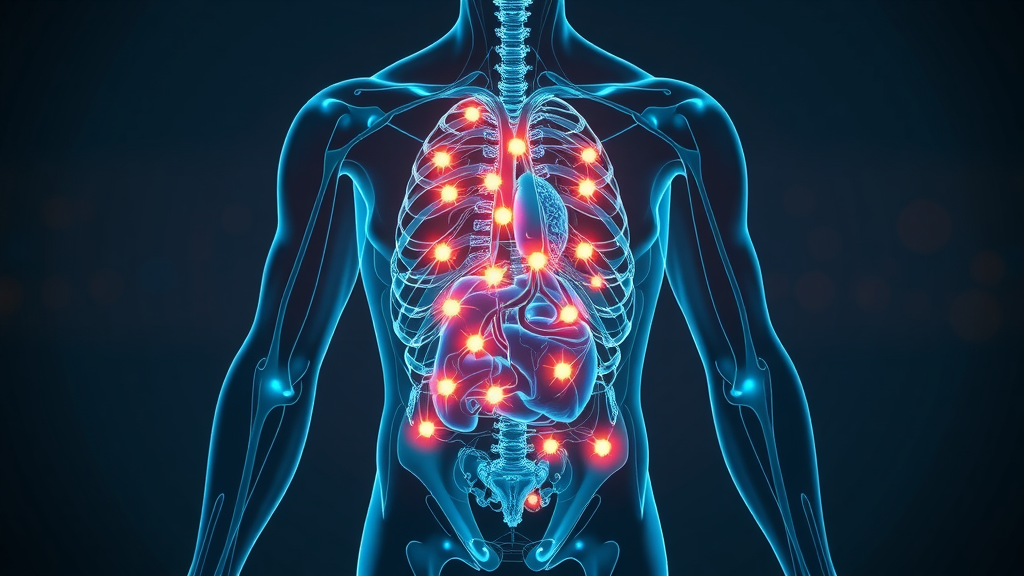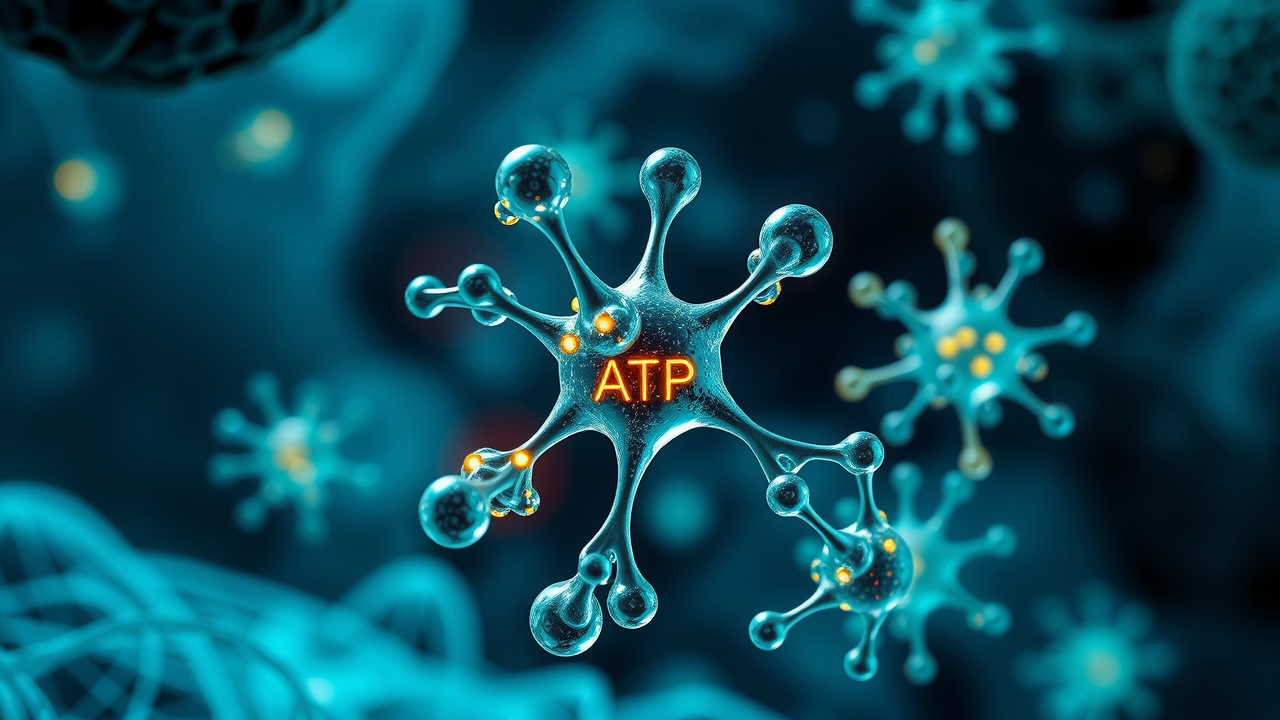Did you know your body churns through more than 50 kilograms of ATP for energy every single day? That’s heavier than some suitcases! But if you’re feeling sluggish, depleted, or struggling to keep up with life’s demands, your cells might not be getting the fuel they need. ATP—our cells’ primary power source—has the ability to reignite your energy reserves , helping you feel sharp, strong, and vibrant again. In this article, we’ll unravel the fascinating science of ATP and give you actionable strategies to boost your energy where it matters most—at the cellular level.
Did You Know? Over 50kg of ATP for Energy Is Used by Your Body Daily
It might sound unbelievable, but the average adult reuses and recycles over 50 kilograms of ATP molecules (adenosine triphosphate) every 24 hours. That’s because every cell—whether it’s in your brain, muscles, or even your heart—depends on a constant supply of ATP for energy to power daily processes. Each one of your 30+ trillion cells can only store a tiny amount of ATP at a time, meaning it needs to be replenished and regenerated almost continuously.
From muscle contraction during a morning jog to the nerve impulse powering thought and memory, ATP is the “currency of the cell,” exchanging its high-energy phosphate bonds for the energy your body needs to survive and thrive. And because ATP molecules are recycled so quickly through processes like cellular respiration in mitochondria, any disruption in ATP energy production can lead to low energy, physical fatigue, and mental sluggishness. Understanding your body’s energy needs is the first step to turning things around.

-
The science behind ATP for energy and why it’s crucial for every cell
-
Practical ways to boost ATP for energy quickly and naturally
-
The role of adenosine triphosphate function in daily performance and wellness
-
Common questions about mitochondria and ATP answered by experts
ATP Hydrolysis Energy: Understanding the Powerhouse Molecule
The ATP Role in Cells
ATP, or adenosine triphosphate , is a simple yet spectacular molecule. It consists of an adenine (a nitrogenous base), a ribose sugar , and three phosphate groups tightly bound together. When your body needs instant energy, it breaks one of the phosphate bonds (commonly the bond between the second and third phosphate), releasing a burst of "free energy" that can be harnessed for activities as basic as breathing or as complex as running a marathon.
Every cellular process that demands energy—from the beating of your heart to the firing of neurons—relies on the efficient cycling of the ATP molecule. ATP acts as the universal energy carrier, transporting and delivering the energy obtained from the breakdown of food and oxygen to every cell in your body. Without an adequate supply of ATP, cells quickly become dysfunctional, leading to weakness, brain fog, and overall sluggishness.
Adenosine Triphosphate: How ATP Molecules Support Vital Functions
The incredible utility of ATP molecules becomes clear when you realize they’re involved in nearly all critical functions in the body. ATP and muscle contraction during workouts, sustain nerve impulses in the brain and nervous system, and even drive the synthesis of proteins and nucleic acids. These roles underscore why recycling ATP for energy is a 24/7 job; the human body can only store enough ATP to last a few seconds of high-intensity effort.
To keep up with these demands, your mitochondria—the famous “powerhouses of the cell”—work nonstop to generate ATP through a process called aerobic respiration . This process harnesses the energy from carbs, fats, and proteins, converting it into a steady supply of ATP. Any disruptions, whether due to nutrient deficiency, poor sleep, or high stress, can hamper this output, leading to compromised cellular function and poor energy levels.

The Science of ATP Hydrolysis: Unleashing ATP for Energy
ATP Hydrolysis: How Energy Is Released for Daily Action
The power of ATP for energy is unlocked through a process called ATP hydrolysis . During this reaction, a water molecule is used to cleave the bond between the last two phosphate groups in ATP, resulting in the formation of adenosine diphosphate (ADP) and an inorganic phosphate . This seemingly simple process releases energy instantly—energy which is immediately put to use by your muscles, nerves, and countless cellular processes .
Every movement, thought, and heartbeat is powered by the energy liberated from this bond. The efficiency of this system means that after ATP is split into ADP, your cells rapidly regenerate it using mitochondrial enzymes like ATP synthase . Efficient ATP hydrolysis is essential for everything from a quick sprint to effective recovery after a tough gym session, and it’s why even minor interruptions in ATP cycling can quickly lead to symptoms like weakness or mental fatigue.
Signs Your Body Needs More ATP for Energy
-
Persistent fatigue and sluggishness
-
Weakened muscle contraction during exercise
-
Trouble concentrating or brain fog
-
Slower recovery from physical activity
If you consistently experience any of the symptoms above, your body may be signaling a deficit in ATP for energy production or recycling. These issues can stem from poor nutrition (insufficient magnesium or B vitamins), chronic stress, dehydration, or lack of exercise—all factors that can impact the mitochondrial matrix and overall efficiency of ATP generation. Addressing these root causes early on can pay big dividends in restoring your energy.
Remember, ATP is not stored in bulk; it must be synthesized continually. When your body cannot keep up with demand, the ripple effect impacts both mental sharpness and physical stamina. Listening to these warning signs is essential for preventing burnout and ensuring your cells get the fuel they need to support everything from daily movement to long-term wellness.
Proven Strategies to Increase ATP for Energy Naturally
Nutrition and Lifestyle Changes to Boost ATP Molecules
-
Emphasize nutrient-rich foods (magnesium, B vitamins)
-
Hydration and oxygenation
-
Consistent movement and interval exercise
-
Prioritize restful sleep
Fueling your body for better ATP for energy production starts in the kitchen and extends to your daily routine. Prioritize foods that are naturally rich in magnesium (like spinach and almonds), B vitamins (from whole grains, tuna, and chicken), and healthy fats (such as salmon and avocados). These nutrients serve as raw materials and cofactors in the ATP synthesis process . Drinking enough water and ensuring plenty of oxygen through deep breathing or aerobic activity further supports your mitochondria’s efficiency.
Movement is another crucial factor. Even moderate exercise can enhance mitochondrial density, increasing your capacity to generate ATP . Interval workouts and consistent activity boost enzyme systems involved in aerobic respiration . Lastly, eight hours of deep, restful sleep gives your body time for essential repair and optimal ATP recycling.

Supplements That Support Energy Metabolism ATP
-
Creatine monohydrate
-
Coenzyme Q10
-
D-ribose
-
Alpha-lipoic acid
While lifestyle changes form the foundation of healthy ATP metabolism, several supplements have been studied for their ability to help produce or recycle ATP for energy. Creatine monohydrate is renowned for supporting rapid energy release in muscle cells during intense activity, partly by donating phosphate groups to regenerate ATP from ADP. Coenzyme Q10 (CoQ10) acts as a critical electron transporter within mitochondria, helping accelerate ATP synthesis, particularly in energy-demanding organs like the heart and brain.
For those recovering from illness or faced with high physical demands, D-ribose (a sugar ribose molecule) may assist in replenishing depleted ATP stores, while alpha-lipoic acid supports mitochondrial health by combating oxidative stress. Remember, these supplements work best with a nutritious diet and active lifestyle—they provide a “boost,” not a replacement, for natural processes.
"The ability of our cells to rapidly regenerate ATP for energy is at the heart of sustaining physical and mental performance." — Dr. Sarah Lee, Cellular Biochemist
Table: Nutrients and Their Impact on ATP for Energy
|
Nutrient |
ATP Synthesis Support |
Food Source Example |
|---|---|---|
|
Magnesium |
Cofactor for ATP molecule formation |
Spinach, almonds |
|
Vitamin B3 |
Essential for cellular energy transfer |
Tuna, chicken |
|
CoQ10 |
Helps regenerate ATP molecules |
Salmon, organ meats |
How ATP and Muscle Contraction and Powers Recovery
Adenosine Triphosphate and Efficient Muscle Contraction
The essential connection between adenosine triphosphate and muscle contraction is why athletes and weekend warriors alike pay close attention to their ATP status. Muscle fibers require a sharp influx of ATP for each contract-relax cycle —without it, muscles simply can’t function at full capacity. The energy fuel provided by ATP also makes faster recovery possible, allowing physical activities to be repeated with less fatigue and less risk of injury.
During high-intensity exercise, ATP is split into ADP and an inorganic phosphate, a process aided by specialized enzymes. As these stores become depleted, cellular respiration ramps up to regenerate ATP, with endurance and recovery hinging on this rapid cycle. Insufficient ATP causes muscles to tire more quickly and makes post-workout soreness linger. Thus, optimizing your diet, sleep, and stress levels not only lifts your day-to-day energy but can also supercharge your workouts.
[Watch a dynamic animation that brings the power of ATP for energy to life, showing how each ATP molecule fires up energy production inside your cells.]
People Also Ask: What does ATP do for energy?
ATP ( adenosine triphosphate ) acts as the primary energy currency of your body, directly fueling processes from muscle movement to nerve signaling by transferring energy with each phosphate bond depletion. When a phosphate group is removed, energy is released and made available for countless chemical reactions inside your cells.

People Also Ask: How to increase ATP in body?
Increase ATP for energy by consuming a balanced diet rich in magnesium, B vitamins, and healthy fats , maintaining regular aerobic and resistance exercise, managing stress, and considering evidence-based supplements such as CoQ10 and creatine . Hydration, good sleep, and limiting processed foods further support ATP synthesis within the mitochondrial matrix .
People Also Ask: Is ATP a good supplement?
While direct ATP supplementation has limited absorption and bioavailability, supplements that support ATP production or recycling —like creatine, D-ribose, and magnesium—are shown to support energy levels in active individuals. These compounds help the body make efficient use of its own ATP synthesis pathways for better physical and mental performance.
People Also Ask: What happens when ATP levels are low?
When ATP for energy is low, symptoms can include fatigue, muscle weakness, mental dullness, and impaired exercise performance , signaling a need to improve nutrition, rest, and stress management or address underlying health concerns that disrupt mitochondrial function.
Frequently Asked Questions About ATP for Energy and Adenosine Triphosphate
-
Can you test ATP levels at home? Currently, there are no widely available home tests for ATP levels; most assessments are done in research or clinical labs.
-
Is ATP safe for everyone? ATP is naturally produced and managed by the body. ATP-supporting supplements, when taken as directed, are generally safe for most adults but should be discussed with a healthcare provider if you have health concerns.
-
Does ATP decline with age? Yes, mitochondrial efficiency and ATP production can decrease with age, which is why healthy habits become even more important over time.
-
Are there natural ways to boost ATP daily? Absolutely—nutrition, exercise, sleep, and stress management all help to sustain high levels of ATP for energy throughout life.
Key Takeaways for Maintaining Optimal ATP for Energy Levels
-
ATP for energy is vital for every cell and function
-
Nutrition, movement, and stress management boost ATP molecules
-
Both adenosine triphosphate recycling and production matter
-
Targeted supplements can help when used wisely
Ready to Boost Your ATP for Energy? Take the Quiz and Jumpstart Your Wellness
Want to recharge your body naturally? We’ve created a quick 45-second quiz that helps uncover what your body might really need right now. 👉 [Take the quiz →]
 Add Row
Add Row  Add
Add 




Write A Comment